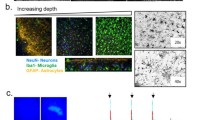Abstract
Organotypic slice cultures have been prepared from the brains of transgenic mice with Alzheimer’s disease-type pathology. Cell types within the slice undergo differentiation and slices can be maintained in culture for up to 6 mo when prepared from young neonates. Slices have been prepared from mice overexpressing genes of relevance to Alzheimer’s disease, including mutant or wild-type tau. Neurons in these slices develop neurons that are immunoreactive for a number of markers of abnormal tau. Organotypic slice models are currently being used to test the impact of tangle enhancers or inhibitors as a prescreen for efficacy before testing drugs in vivo.
Similar content being viewed by others
References
Bahr B. (1995) Long-term hippocampal slices: a model system for investigating synaptic mechanisms and pathologic processes. J. Neurosci. Res. 42, 294–305.
Bahr B. A., Kessler M., Rivera S., Vanderklish P. W., Hall R. A., Mutneja M. S., et al. (1995) Stable maintenance of glutamate receptors and other synaptic components in long-term hippocampal slices. Hippocampus 5, 425–439.
Duff K., Knight H., Refolo L. M., Sanders S., Yu X., Picciano M., et al. (2000) Characterization of pathology in transgenic mice overexpressing human genomic and cDNA tau transgenes. Neurobiol. Dis. 7, 87–98.
Jicha G. A., Bowser R., Kazam I. G., and Davies P. (1997) Alz-50 and MC-1, a new monoclonal antibody raised to paired helical filaments, recognize conformational epitopes on recombinant tau. J. Neurosci. Res. 48, 128–132.
Lewis J., McGowan E., Rockwood J., Melrose H., Nacharaju P., Gwinn-Hardy K., et al. (2000) Neurofibrillary tangles, amyotrophy, and progressive motor disturbance in tau mutant (P301L) transgenic mice. Nat. Genet. 4, 402–405.
Author information
Authors and Affiliations
Corresponding author
Rights and permissions
About this article
Cite this article
Duff, K., Noble, W., Gaynor, K. et al. Organotypic slice cultures from transgenic mice as disease model systems. J Mol Neurosci 19, 317–320 (2002). https://doi.org/10.1385/JMN:19:3:317
Received:
Accepted:
Issue Date:
DOI: https://doi.org/10.1385/JMN:19:3:317




